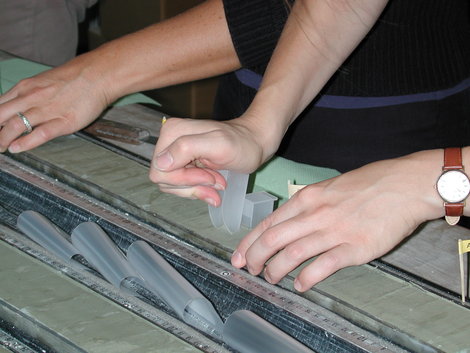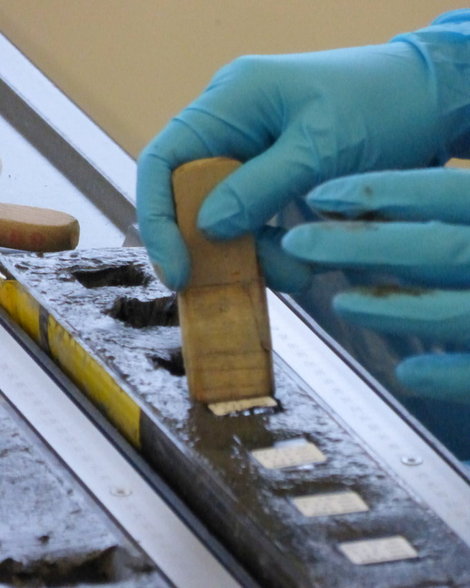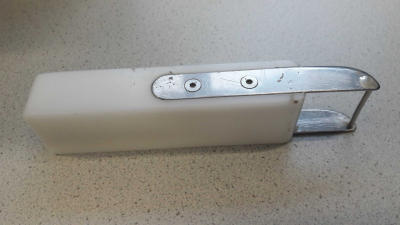Die Inhalte dieser Seite sind leider nicht auf Deutsch verfügbar.
Seitenpfad:
- IODP at MARUM
- IODP Bremen Core Repository
- BCR Practices and Procedures
BCR Practices and Procedures
Core Storage
- Cores are stored in a reefer (refrigerated storage area) maintained at a temperature of +4°C. An alarm is set off if the temperature in the reefer warms significantly for an extended period of time. The alarm is received by Facilities Maintenance staff, at which point technicians are immediately dispatched to address the problem.
- Cores in the repository are routinely stored in plastic d-tubes housed in galvanized racks. Each rack unit holds 840 d-tubes. The lower halves of the core racks are populated with working halves, while the upper sections hold the corresponding archive halves.
- Cores are received from the ship already wrapped in standard plastic foil (sediment cores) or 50µm shrink-wrap film (hardrocks). The film is used to hold rock pieces in place in the d-tube during transit and storage.
Core Sampling Process and Procedures
- When filling a sample request, cores are transported from the reefer into the laboratory area on small carts. Each core section to be sampled is removed from its d-tube, unwrapped if it’s a sediment section, and placed on a specially designed core table. Note: Nitrile powder-free gloves are available for use by the core sampler.
- When a sample is removed from the core, the void left behind is filled with a pre-cut virgin ethafoam spacer that helps maintain the shape and position of the remaining core material.
- Sampled cores are re-wrapped in either foil or shrink wrap, returned to their d-tubes and cart, and returned to their locations in the reefers.
- If sampling of the cores is not completed by the close of daily operations, the cart is returned to the reefer for overnight storage. Sediment cores are not left out in the lab overnight.
- Each sample taken from a core is entered into the CurationDIS database, labeled, bagged, and sealed before shipping. A DIS graphic program has been developed to accurately show the extent of depletion in the cores.
- If cores are required for display purposes and are left exposed on the core tables for a substantial length of time, they are kept wrapped, unless a special request is made, in which case they are opened for a short viewing period and then re-wrapped immediately.
- We can ship DSDP/ODP/IODP samples to investigators who have submitted an official sample request. The samples are sent by a recognized commercial courier and can be tracked at any time. Samples are usually delivered within 2 to 3 working days of the shipping date.
- Although there is no IODP program-wide policy obligation for post-moratorium sample requesters to publish the results obtained from their samples, the BCR, in evaluating sample requests for approval, takes into consideration a reasonable past publishing performance of the requester including whether data obtained from prior received data were made publicly available within 36 months as indicated to the IODP Sample, Data, and Obligations policy.
Frozen Microbiology Samples
- Frozen MBIO samples are usually shipped directly from the ship to the investigators or, in the case of Routine Microbiology Samples, to the repository. The samples are packed in coolers on dry ice. As soon as they are received, the samples are inventoried and transferred to a –80°C chest freezer. After the moratorium, information detailing the sample position is published online.
- In case of a power outage or mechanical failure, the freezers have audible temperature alarms that sound when the temperature rises above –70°C. The freezers are also attached to a “sensa-phone system” that notifies curatorial staff, by mobile phone, of a high-temperature situation or power failure. An empty freezer is maintained at –80°C temperature in case samples need to be quickly transferred from a defective freezer.
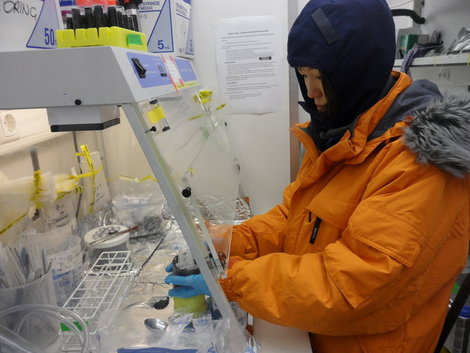
Sample Residues
- Sample residues, returned either from the ship or by requesting scientists, are preserved in cardboard or plastic storage boxes, labeled and organized according to Expedition, and stored on flat shelves in a special section of the reefer.
Smear Slides
- Smear slide examination is an essential aspect of the description of the finegrained materials (mud) that dominate marine sedimentary successions.
Smear slides produced on board IODP drilling vessels are returned to the repository directly from the ship. Once at the BCR they are inventoried and stored in cabinets. The smear slides are available to scientists on loan for a period of 1 year under the terms of a loan agreement. - Marsaglia et al.(2013) prepared a smear slide atlas and tutorial on behalf of IODP Management International (IODP-MI), Inc. The goal of this tutorial is to convey the essentials of the smear slide method to sedimentologists engaged in marine core description on board IODP drilling vessels or at IODP core repositories.
Study of this tutorial will help core describers develop and apply solid skills
in the identification and semiquantification of mud components.
- IODP Smear Slide Digital Reference for Sediment Analysis of Marine Mud Part 1: Methodology and Atlas of Siliciclastic and Volcanogenic Components (Interactive Edition) (Print Edition)
- IODP Smear Slide Atlas - Slide Tutorials (Interactive Edition) (Print Edition)
Marsaglia, K., Milliken, K., and Doran, L., 2013. Smear slides of marine mud
for IODP core description, Volume I. Part 1: Methodology and atlas of
siliciclastic and volcanogenic components. IODP Technical Note 1.
doi:10.2204/iodp.tn.1.2013
- IODP Smear Slide Digital Reference for Sediment Analysis of Marine Mud Part 2: Methodology and Atlas of Biogenic Components. (Interactive Version)
Marsaglia, K., Milliken, K., Leckie, R., M., Tentori, D., Doran, L., 2015. IODP
Smear Slide Digital Reference for Sediment Analysis of Marine Mud. Part 2:
Methodology and Atlas of Biogenic Components. IODP Technical Note 2.
doi:10.14379/iodp.tn.2.2015 - You may also want to consider the satellite MRC collection at MARUM.
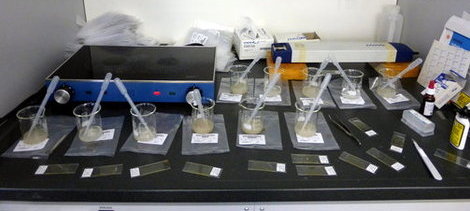
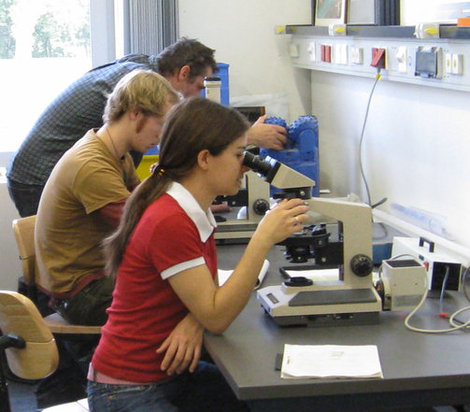
Thin Sections
- Thin sections produced on board for the scientific party are always sent to the repository directly from the ship. Once at the BCR they are inventoried and stored in cabinets.
- The thin sections are available to scientists on loan for a period of 1 year under the terms of a loan agreement.
- Lists of available thin sections are available upon request.
U-channels
- U-channels are routinely taken post cruise at the repository by the requestor.
- Once the u-channel is cut from the core a pre-cut virgin ethafoam spacer is used to fill the void.
- The u-channels are packed in spare d-tubes and cardboard boxes prior to shipping. Wooden (wood approved for international shipping) shipping crates are specially made to house 4–6 boxes each in order to protect the fragile u-channels during shipping and facilitate their safe return to the repository. Standard core boxes containing u-channels are limited to 30 kg when shipped by courier.
- In order to receive the u-channels for non-destructive measurements a loan agreement is signed by the requestor accepting a loan term of 1 year and agreeing to maintain the cores, for the duration of the loan, in a suitable refrigerated storage facility.
- No sub-sampling is permitted from the u-channels unless by prior agreement.
- U-channels at the BCR are stored in the core reefer.
Core Loans
- Core loans may be requested by individuals for a number of reasons including educational request, museum displays, scanning, etc. The terms of core loans vary by the terms and conditions of each specific request and must be approved by the Curator.
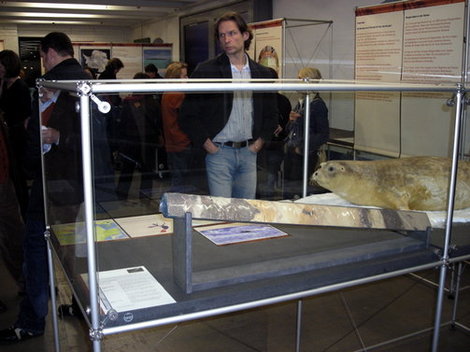
IODP Sample, Obligation, and Data Policies
- These policies can be found here.
Archive and Working Halves
Core sections are split into halves for shipboard (or MSP Onshore Science Party) analysis, to uniquely identify split-core halves for measurements and sampling. The halves are designated as the “working half” and “archive half.” The entire working half is available for sampling. In certain circumstances the archive half may also become available for sampling.
Archives - Permanent and Temporary
A “minimum permanent archive” is established for each IODP coring site. Archive section halves designated as “permanent” are initially preserved unsampled in the core repositories for nondestructive examination and analysis. This minimum permanent archive will consist of at least one set of archive-half sections that cover the entire recovered sequence at a given site. Sections not designated as permanent archives are considered “temporary archives.” The temporary archive may be sampled just as the working halves are when the working halves no longer contain appropriate material for the required sampling.
a) If the holes at a site are cored continuously, the minimum permanent archive may consist of the archive halves of all sections of the deepest hole. In this case, the archive halves from additional holes need not be designated as permanent archive, but may be, if so desired by the Sample Acquisition Committee (SAC), for example, in the case of Critical Intervals (see below).
b) If a Composite Splice (see below) section is constructed at a site and the sampling demand exceeds the available material in the working half, an alternative strategy may be required to ensure that all samples can be taken from the spliced section. In this case, the permanent archives can be defined from cores that are outside of the splice as long as the entire recovered sequence is available outside the splice.
Sampling of the permanent archives may be considered five years postcruise if the working and/or temporary archive halves of the core have been depleted.
a) If the holes at a site are cored continuously, the minimum permanent archive may consist of the archive halves of all sections of the deepest hole. In this case, the archive halves from additional holes need not be designated as permanent archive, but may be, if so desired by the Sample Acquisition Committee (SAC), for example, in the case of Critical Intervals (see below).
b) If a Composite Splice (see below) section is constructed at a site and the sampling demand exceeds the available material in the working half, an alternative strategy may be required to ensure that all samples can be taken from the spliced section. In this case, the permanent archives can be defined from cores that are outside of the splice as long as the entire recovered sequence is available outside the splice.
Sampling of the permanent archives may be considered five years postcruise if the working and/or temporary archive halves of the core have been depleted.
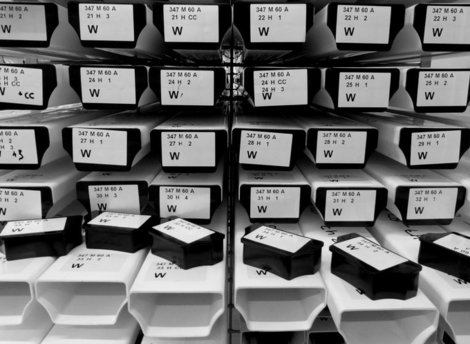
Composite Splice
Paleoceanographic cruises typically recover sediment cores from multiple holes at a given site. A composite stratigraphic depth section is constructed by establishing correlations between adjacent holes. The offsets between holes are used to calculate the meters composite depth (mcd) values for each hole. A “splice table” indicates the intervals in each hole at a site that have been combined to construct the “ideal” section, known as the “composite splice.” The purpose of a composite splice is to describe the most complete sedimentary section at a given site, avoiding gaps in core recovery, which then can be used for developing high-resolution sampling strategies.
Critical Intervals
Critical intervals are lithologic spans of such scientific interest that there is extremely high sampling demand for them. These intervals may vary from thin, discrete horizons to thick units extending over an entire core or more. Examples include, but are not limited to, significant geological boundaries, décollements, sediment-basement contacts, igneous contacts, impact/tektite horizons, gas hydrates, marker ash horizons, magnetic reversals, and particular biostratigraphic levels. The SAC is responsible for anticipating the recovery of critical intervals or recognizing unexpected ones as they arise, and for developing a strategy for sampling and/or preserving them. For post-moratorium sampling, the IODP Curator at the appropriate repository will work with investigators to ensure that previously defined critical intervals are sampled only when necessary.
Typical Sample Volumes
The following volumes are guidelines, not limits.
- Thin section billets: 10 cm3 up to 50 cm3 for large-grained plutonic rocks
- Alkenone (Uk 37): 5 cm3
- X-ray diffraction: 5 cm3
- X-ray fluorescence: 20 cm3 (sediments), 20–50 cm3 (igneous/sulfides—varies
depending on grain size and homogeneity of rock) - Carbonate: 2 cm3
- Paleomagnetism: 7-cm3 cubes; 12-cm3 minicores; 600-cm3 u-channels
- Moisture and density: 10–20 cm3
- Grain size: 10–20 cm3, depending upon coarseness
- Planktonic foraminifers: 10 cm3
- Benthic foraminifers: 10–20 cm3
- Nannofossils: 2 cm3
- Diatoms: 5–10 cm3
- Radiolarians: 10 cm3
- Palynology: 10–15 cm3
- Organic samples: 20 cm3
- Stable isotopes (C, O): 10–20 cm3
- Interstitial pore-water whole rounds: 5–20 cm long, based on water content
- Inorganic geochemistry: 10 cm3
- Organic geochemistry: 10 cm3
- Sedimentology: 10–20 cm3
- Slabs (for laminae studies): 25–50 cm3, depending on slab length
- Slabs (large grained plutonics): 50–100 cm3, often shared by scientists for multiple analyses
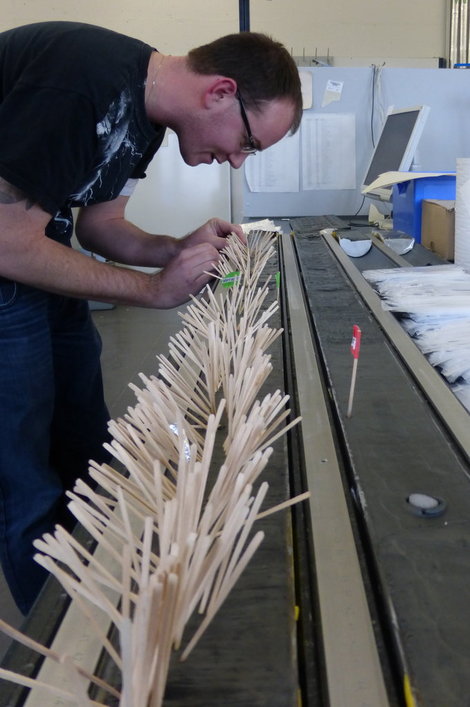
Unique Intervals
A cored interval is designated “unique” if it has been recovered only once at a drill site. This is always the case when only one hole is drilled at a site. If an equivalent interval is recovered from two or more holes, then the interval is considered “non-unique.” When drilling into igneous basement rocks, metamorphic rocks, or metalliferous deposits, every hole drilled is considered to be unique because of the inherent lateral heterogeneity. Lithostratigraphic analysis of advanced piston cores from multiple holes drilled at one site may reveal that short sedimentary intervals (generally less than 2 m) are commonly missing between successive cores from any one hole, even where nominal recovery approaches 100%. These missing intervals may be ignored when considering whether or not an interval is unique.
Whole-Round Samples
Whole-round samples are collected for special analysis (e.g., interstitial water analysis, microbiology sampling) and pre-defined purposes (e.g., "community" whole rounds proposed early by science party members). Intervals of whole rounds depend on the pre-defined purposes of sampling and type of special analyses applied. The Sample Allocation Committee (SAC) is responsible for developing a strategy for whole-round sampling in the early stages of expedition planning and for including a clear description of the whole-round sampling strategy in the IODP Scientific Prospectus.




